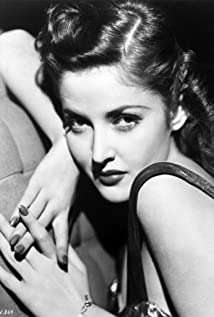Martha Vickers (I)
Lovely, auburn-haired Martha Vickers (nee Martha MacVicar) was born in Ann Arbor, Michigan, on May 28, 1925, the daughter of James S. and Frances MacVicar. After attending schools in various states - Florida, Texas and California - she and her family settled on the West Coast. A raving beauty, she broke into the entertainment field as a model for still photographer William Mortenson. This attracted the interest of David O. Selznick and she signed a starlet contract with him, but nothing came of it. Universal took over her contract where she was groomed in inauspicious bit parts such as her corpse/victim in Frankenstein contra el hombre lobo (1943), and in such low-level entries as La mujer fiera (1943) and La princesa y la momia (1944). In between assignments, Martha earned WWII pin-up exposure in such magazines as "Yank: The Army Weekly."
RKO gave her some higher-level billing chances with El frente del amor (1944) and El Halcón en México (1944), but it was Warner Bros. that put her officially on the map. The enticing Martha earned celebrity status and a new stage moniker when she generated some real heat as Lauren Bacall's wild, thumb-sucking sister Carmen in the film noir classic Al borde del abismo (1946), which also starred Humphrey Bogart, playing the teenage nymphet "bad girl" for all it was worth. This major success quickly led to other "B" roles and not necessarily all "bad girl" parts. Highly appealing as the second femme lead in the pleasant musical La sinfonía del amor (1946), Martha looked radiant but was overlooked for bigger things. She continued on and disrupted the proceedings again in the atmospheric film noir Mi único amor (1946) with Ida Lupino and finally earned leading lady status in El pobre ricachón (1947) opposite Dane Clark.
Very much a part of the Hollywood dating scene, which included actor James Stewart and director Frederick De Cordova, Martha finally married producer A.C. Lyles in March of 1948, but the marriage was over within a couple of months. Post-war films included Ama y aprende (1947), another film noir piece El insaciable (1948), and the melodrama El malhechor (1949), which was Audie Murphy's first starring role. She ended the decade top-lining the "Poverty-Row" drama Alimony (1949). Surprisingly, Martha's high-profiled second marriage in 1949 to film star Mickey Rooney (she was his third wife) did not advance her career. In fact, Martha was not seen in films at all during this period. Despite the couple having a son, Teddy Rooney, the next year (1950), Rooney had already hit the nadir of his career and had turned excessively to the bottle. Her marriage to Rooney would be short-lived as well.
Martha married a third time in 1954 to Chilean polo player-turned-actor Manuel Rojas, best known for his co-starring role in The Magnificent Matador (1955), and she finally returned to the screen in The Big Bluff (1955) co-starring with John Bromfield. The momentum, however, was gone and the movie did nothing to generate new interest. She did move, however, into TV and performed effectively in a number of dramatic showcases. She and Rojas had two children, Tina and Tessa. In 1960, Martha did her last filming with the western La sombra de su pasado (1960) and after guesting on a couple of episodes of the TV series "The Rebel," ended her career. Not much was heard from this sultry beauty until her death from cancer in 1971 at age 46 in Hollywood, California.

